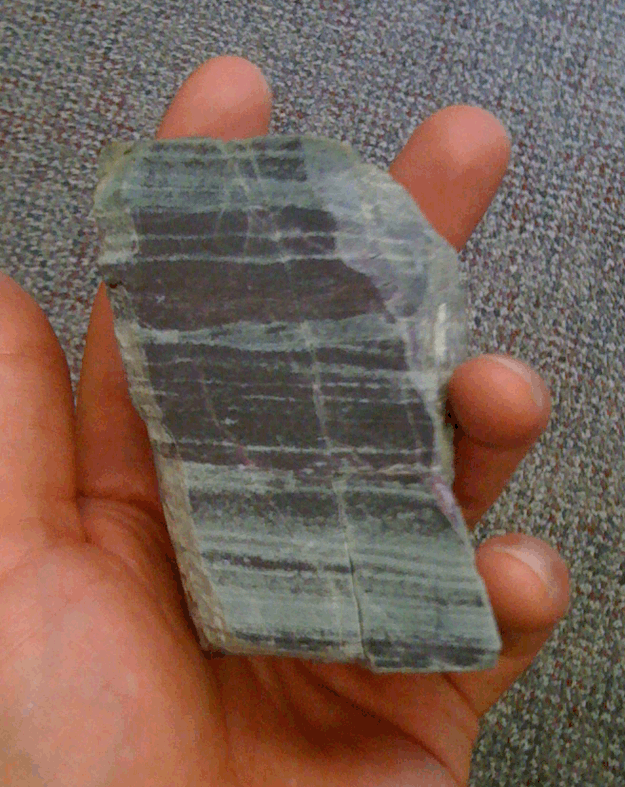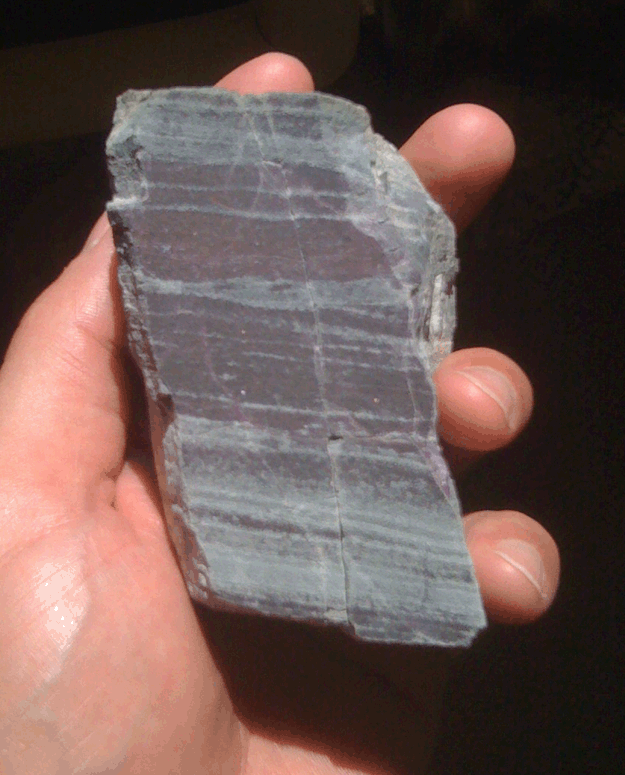Can you tell me why I am very excited to be holding this rock in my hand?


(iPhone photos; apologies for the low quality. But the rock… is anything but low.)
Can you tell me why I am very excited to be holding this rock in my hand?


(iPhone photos; apologies for the low quality. But the rock… is anything but low.)
If the red is garnet and the green is omphacite (The favorite pyroxene of Oompa loompas), then you have a severely deformed eclogite in your hand. Eclogite is basalt that recrystallizes from basalt (plagioclase + pyroxene) to garnet + (green, low iron) clinopyroxene, when it gets pulled down into the mantle, at pressures greater than 20,000 times atmospheric. The texture is a bit odd, for that, though, so if I’m wrong, I’ll blame the photo.
Nice first attempt – but the red/purple is a calcite stain. Note that calcite is present in moderate amounts… But the rest is something else…
Is it banded ironstone formation?
Nope, it wasn’t ever B.I.F….
A stromatolite?
My guess: very ancient microbial mats crushed into ferroan calcite and ferroan dolomite laminations; Belt Supergroup.
heh – didnt mean that to be a reply to Alex (didnt even see it when I started typing), but it makes sense that it is there since he guessed it first
Nope… Go higher…
Could it be a piece of K-Pg boundary?
It kind of looks varved
Well, since it contains calcite, and knowing you’re probably not one to get all tore-up over a sedimentary rock, I’m going to take a wild guess and say it’s a flow-banded carbonatite, which would make it really weird igneous rock, and quite rare.
Okay, here’s the current roster of conversation (including major hints) from Facebook over the course of the day:
Trevor XXXXXXXXXXXX Slickensides?
14 hours ago
Carol XXXXXXXXXXXX It shows a picture of Jesus.
Callan Bentley Won’t you people EVER get it right? I swear, I can’t REST until you do… 😉
Brandon XXXXXXXXXXXX boundary rock?
Callan Bentley Boundary between what and what?
Brandon XXXXXXXXXXXX I meant temporally, like a contact between two different periods. (Always my favorite rocks)
Pamela XXXXXXXXXXXX Cretaceous-Tertiary (i.e. Paleogene) boundary with iridium anomaly?
Callan Bentley If only you could find someone who knew the answer… You could trust HIM and it would ALLAY your concerns… Ahhhh…. 😉
Callan Bentley Major hints in previous responses — break it down, people…
OK, well, it’s obviously a rock from Mt. Everest in the Himalayas. I’m going to guess it’s the shale that makes up the middle of Everest, between base camp and ~27,000 feet.
Bingo. Or close enough. Actually, not quite high enough…
This is a sample from the highest elevation outcrop on the planet Earth. Though the summit of Mount Everest is swathed in ice and snow, about 20 feet below the summit is an outcrop of sheared Ordovician dolomite. Dr. Dave Lageson of Montana State University is collaborating with famed mountaineer Conrad Anker to work on several problems in the Himalayas, focused on Everest. Anker collected this sample last year, and Dave and he will return to the big mountain in February for additional sampling and field work. More details at Dave’s lab page:
http://www.montana.edu/wwwes/facstaff/lageson.htm
Dave and I sat down for an hour last Friday morning, talking about this and other things, and he’s quite jazzed about it. The Himalayas! Awesome.
John McPhee noted the singular fact that the summit of the planet’s highest point is made of rock that formed in the ocean. That’s the power of plate tectonics… absolutely astounding. The hair stood up on the back of my neck as I held this sample in my hand.
Argh, it is the top layer. When you told Lemming it wasn’t calcite, I decided it couldn’t be the limestone/dolomite on the top layer. Wasn’t reading closely enough.
In any case, very very very cool.
heh. The whole damn mountain is sedimentary, and not particularly tough rock either. There is a video of Anker free climbing the second step, and the rock is downright crappy. The Yellow Band (the layer just below the sample) is famous for being crumbly.
Which further demonstrates the dynamic forces at work in the Himalaya – relatively weak rocks thrust that high despite the outrageous forces of erosion at work on such peaks.
i think that is really cool! i am in grade 4. i will probably use this for a project….